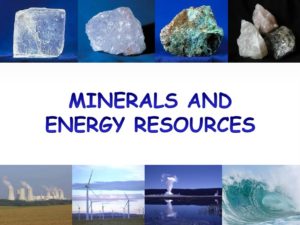You probably know the importance of electricity. Without it, how would you even read? However, this is just the tip of the iceberg. There are so many types of mineral and energy resources without which our lives would be so difficult. In this chapter, we will look more into the details of minerals and energy resources.
Suggested Videos
What are Minerals?
Minerals are homogeneous naturally occurring substances normally found in solid, liquid and gaseous state.
Types of Minerals
Minerals are classified into two types: Metallic and non-metallic.
Metallic Minerals: They are further sub-divided into ferrous and non-ferrous.
- Ferrous minerals: They contain iron.
Examples are iron ore, manganese ore, chromite, pyrite, nickel, and cobalt. - Non-ferrous minerals: They contain metals other than iron.
Examples include gold, silver, copper, lead, bauxite, tin and magnesium.
Non-metallic Minerals: They are limestone, nitrate, potash, mica, gypsum, coal, petroleum.
Distribution of Minerals
In this section, we will look at the distribution of various minerals.
Iron Ore
Iron ore is the basic mineral. It forms the backbone of industrial development. There are four varieties of iron ore :
- Limonite
- Haematite (contains 60% to 70% iron) – Most important industrial iron ore.
- Magnetite (contains 70% iron) — Finest quality, with magnetic properties.
- Siderite (contains 40% to 50% iron)
Manganese Ore
Manganese ore is used for making iron and steel. It is also used in preparing alloys. It is used to manufacture bleaching powder, insecticides, paints, and batteries.
Bauxite
Aluminium is obtained from bauxite. It is used in the manufacturing of aeroplanes, utensils and other household goods. Bauxite is mainly found in Jharkhand, Orissa, Gujarat, Maharashtra, Chhattisgarh.
Limestone
Limestone is composed of calcium carbonate or calcium and magnesium carbonates. Hence, it is used in the cement industry, smelting of iron and in chemical industries.
Conservation of Minerals
Minerals are non-renewable. Hence, they must be conserved. Therefore, we must reduce the wastage of mining and processing.
In addition to this, the government must minimize the export of minerals. Hence, extra care must be given to reduce the wastage of mineral resources.
Learn more about Mineral and Power Resources here.
Energy Resources
The various sources of energy are Coal, Petroleum, Natural Gas. There are some other types of energy like Solar Energy, Wind Energy and Hydel Energy. We can divide the energy resources into two main types. Hence, in the below section, we will discuss them in brief.
- Conventional Energy: Examples include coal, petroleum, natural gas, and electricity.
- Non-Conventional Energy: Examples include solar, wind, tidal, geothermal, atomic energy and biogas.
Therefore, let us now look at the different sources of energy in brief.
Conventional Sources Of Energy
Coal
Coal is the main source of power generation in India. Hence, it meets around 67% of the country’s requirements of power. We use coal in the manufacture of iron and steel. We also use coal as a raw material for the chemical industry. There are four types of coal — Anthracite, bituminous, lignite and peat.

Petroleum
It is the second most important energy source. It acts as a raw material for a number of industries. Mumbai High produces 63% of crude petroleum.
Natural Gas
This is an environment-friendly fuel. Therefore, it acts as a raw material in the petrochemical industry. This is because petrochemicals release other harmful materials. Andhra Pradesh, Maharashtra, Gujarat, Assam and Andaman and Nicobar Islands produce natural gas. Krishna-Godavari Basin also accounts for the major supply areas of natural gas.
Electricity
The installed capacity of India stands at 137500 MW. The per capita consumption of electricity is 379 kWh. In our country, we can generate electricity in various ways. Therefore, let us have a look at them.
- Thermal Electricity: Coal, petroleum and natural gas give rise to thermal energy. Assam, Jharkhand, Uttar Pradesh and West Bengal use this form of generating electricity.
- Hydroelectricity: Water released at a great force from a high head results in hydroelectricity. Therefore, the high force of water can produce electricity in many states.
- Nuclear Electricity: Uranium and thorium give nuclear energy. There are seven nuclear power stations in the country.
Non-Conventional Sources of Energy
The potential of non-conventional sources of energy is large. They use renewable resources for energy generation.
Solar Energy
Photovoltaic technology converts sunlight directly into electricity. Therefore, solar energy is a powerful source of energy in India. This is because India is a tropical country.
Wind Energy
India has a wind power potential of 20,000 MW. Tamil Nadu, Andhra Pradesh, Karnataka, Gujarat, Kerala, Maharashtra, and Lakshadweep are the major areas that harness wind power.
Question For You
Q1. Write a note on the conservation of energy resources.
Ans: In order to conserve energy, we must,
- Use the public transport system more frequently.
- Switch off electricity whenever not required.
- Use power-saving devices.
- Check the power equipment regularly.
- Use non-conventional sources of energy more frequently.
Hence, we will achieve a better state of energy resource conservation.
Q2. Write a note on the types of iron ore.
Ans: There are four varieties of iron ore :
- Limonite
- Haematite (contains 60% to 70% iron) – Most important industrial iron ore.
- Magnetite (contains 70% iron) — Finest quality, with magnetic properties.
- Siderite (contains 40% to 50% iron)







please put up sessions and classes for humanities also…